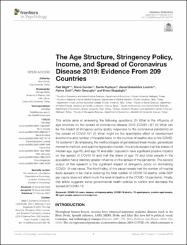| dc.contributor.author | Bilgili, Faik | |
| dc.contributor.author | Dundar, Munis | |
| dc.contributor.author | Kuskaya, Sevda | |
| dc.contributor.author | Lorente, Daniel Balsalobre | |
| dc.contributor.author | Unlu, Fatma | |
| dc.contributor.author | Gencoglu, Pelin | |
| dc.contributor.author | Mugaloglu, Erhan | |
| dc.date.accessioned | 2022-02-27T10:23:21Z | |
| dc.date.available | 2022-02-27T10:23:21Z | |
| dc.date.issued | 2021 | en_US |
| dc.identifier.issn | 1664-1078 | |
| dc.identifier.other | PubMed ID33643117 | |
| dc.identifier.uri | https //doi.org/10.3389/fpsyg.2020.632192 | |
| dc.identifier.uri | https://hdl.handle.net/20.500.12573/1194 | |
| dc.description.abstract | This article aims at answering the following questions: (1) What is the influence of age structure on the spread of coronavirus disease 2019 (COVID-19)? (2) What can be the impact of stringency policy (policy responses to the coronavirus pandemic) on the spread of COVID-19? (3) What might be the quantitative effect of development levelincome and number of hospital beds on the number of deaths due to the COVID-19 epidemic? By employing the methodologies of generalized linear model, generalized moments method, and quantile regression models, this article reveals that the shares of median age, age 65, and age 70 and older population have significant positive impacts on the spread of COVID-19 and that the share of age 70 and older people in the population has a relatively greater influence on the spread of the pandemic. The second output of this research is the significant impact of stringency policy on diminishing COVID-19 total cases. The third finding of this paper reveals that the number of hospital beds appears to be vital in reducing the total number of COVID-19 deaths, while GDP per capita does not affect much the level of deaths of the COVID-19 pandemic. Finally, this article suggests some governmental health policies to control and decrease the spread of COVID-19. | en_US |
| dc.language.iso | eng | en_US |
| dc.publisher | FRONTIERS MEDIA SAAVENUE DU TRIBUNAL FEDERAL 34, LAUSANNE CH-1015, SWITZERLAND | en_US |
| dc.relation.isversionof | 10.3389/fpsyg.2020.632192 | en_US |
| dc.rights | info:eu-repo/semantics/openAccess | en_US |
| dc.subject | COVID-19 cases | en_US |
| dc.subject | income | en_US |
| dc.subject | stringency policy | en_US |
| dc.subject | COVID-19 deaths | en_US |
| dc.subject | 70-aged people | en_US |
| dc.subject | median aged people | en_US |
| dc.subject | 65-aged people | en_US |
| dc.subject | government responses | en_US |
| dc.title | The Age Structure, Stringency Policy, Income, and Spread of Coronavirus Disease 2019: Evidence From 209 Countries | en_US |
| dc.type | article | en_US |
| dc.contributor.department | AGÜ, Yönetim Bilimleri Fakültesi, Ekonomi Bölümü | en_US |
| dc.contributor.authorID | 0000-0001-5362-6259 | en_US |
| dc.contributor.institutionauthor | Mugaloglu, Erhan | |
| dc.identifier.volume | Volume 11 | en_US |
| dc.relation.journal | FRONTIERS IN PSYCHOLOGY | en_US |
| dc.relation.publicationcategory | Makale - Uluslararası - Editör Denetimli Dergi | en_US |


















